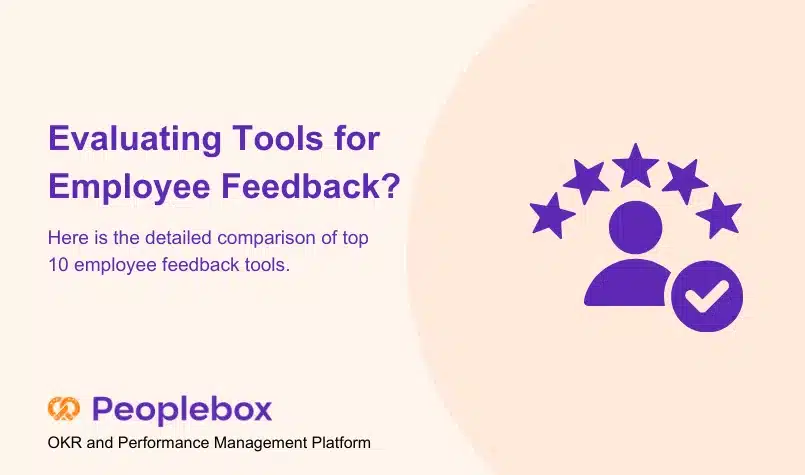TL;DR
360-degree feedback gives a fairer, more complete picture of how an employee is doing. It helps people see their own strengths and weaknesses, so they know how to improve. This process also encourages everyone to talk more openly and work together better as a team. As a result, people are happier in their jobs and are less likely to leave the company.
When a great employee quits, it’s easy to blame it on a better salary offer. But the real story is usually about something else: they felt ignored and undervalued.
This is a major blind spot for companies, because traditional performance reviews don’t measure the factors that create true loyalty, leaving them exposed when top talent decides to leave.
And that is where 360-degree feedback can support you.
What Is 360-Degree Feedback?
A 360-degree review is an in-depth performance assessment process that collects confidential, anonymous feedback on an employee from all they interact with—peers, direct reports, and managers.
This multi-rater platform shows pivotal issues prior to their becoming a problem, making employees feel heard and providing the organization with practical information.
Why Is 360-Degree Feedback Better Than Traditional Review Methods?

Organizations using the 360-degree review model commonly see a measurable increase in morale and retention. The major advantage of 360-degree feedback is that it can find the real reasons for dissatisfaction, keeping valuable employees from quitting.
Here are the top 15 benefits of the 360-degree feedback method for employees and Organizations:
1. Encourages a Culture of Transparency
The most visible effect of 360-degree feedback is that it can change company culture. In contrast to hierarchical reviews that tend to come across as biased, this process encourages honest communication and openness within every department.
This change creates a platform where employees can speak freely without fear, resulting in greater trust and improved decision-making.
2. Enhances Employee Self-Awareness
One of the greatest strengths of 360-degree feedback is the intense gain in self-awareness it offers. By contrasting their own thoughts with the anonymous feedback of others, employees are able to determine blind spots that were previously unknown to them.
This awareness is the basis of all professional growth, allowing individuals to capitalize on their strengths and focus on improving weaknesses.
3. Develops Stronger Leadership Skills
For any company dedicated to growing leaders, this model of feedback provides a subtle understanding beyond what a traditional review can provide.
Direct reports provide a special perspective on a manager’s leadership style, while peers can provide input regarding collaboration and strategic contribution. This provides a complete picture that enables highly specific coaching of leadership.
4. Enhances Communication Throughout the Company
The 360-degree process establishes a formal system for positive conversation. As managers learn to give constructive feedback, and workers learn to receive it, overall communication is enhanced. This becomes a continuing activity that drives better teamwork and mentoring at all levels.
5. Offers a Complete Performance Picture
A traditional review provides one snapshot of performance. A 360-degree review, however, collects feedback from all stakeholders to provide a full picture.
By gathering feedback from the entire team, a 360-degree assessment shows how an employee truly performs over time. This helps you give them a fair and complete review of all their work.
6. Increases Personal Accountability and Ownership
When workers are aware that their performance is being reviewed by peers as well as their immediate manager, their sense of individual responsibility automatically develops.
This increased accountability encourages a stronger work ethic and a clearer focus on objectives.
7. Sharpened Leadership Development Initiatives
The most obvious 360 feedback advantages usually reveal themselves in leadership development. The feedback gives the genuine impression of how an aspiring leader is viewed by their team, as opposed to how they view themselves.
Organizations can use this information to create targeted and personalized development programs.
| Transform Retention with 360-Degree Feedback Top talent doesn’t just leave for better pay: they leave when they feel unseen.360-degree feedback changes that by giving a fair, complete view of performance through insights from managers, peers, direct reports, and even clients. With Peoplebox AI, you can: ✅ Uncover blind spots early ✅ Build trust & transparency ✅ Reduce bias in reviews ✅ Boost engagement & retention Don’t lose your best people. Start Your 360 Feedback Today |
8. Minimizes Unconscious Bias in Reviews
Unconscious bias can compromise the integrity of any conventional, single-manager appraisal. By introducing multiple points of view, 360-degree feedback counteracts personal biases. This multi-source approach makes assessments fairer and more accurate throughout the organization.
9. Enhances Teamwork and Cooperation
The 360-degree assessment model has the power to influence team dynamics by defining communication styles and working strengths.
The process itself becomes a more effective communication practice as team members learn to give and take constructive criticism. These insights enable teams to work together better and carry out projects with greater success.
10. Initiates Innovation Through Diverse Perspectives
One of the major benefits of a 360-degree review is its ability to promote ideas of innovation. Through feedback from multiple levels of the company, it reveals opportunities and solutions often ignored when seen from a one-sided review.
The advantage of 360-degree appraisal is that it provides space for new thinking and keeps the organization competitive.
11. Facilitates Large, Remote, and Project-Based Teams
In remote or large team environments where direct supervision may not be possible, 360-degree feedback is a useful tool. It closes the knowledge gap so that managers can see performance even if there is no face-to-face interaction on a daily basis.
It works particularly well in project teams where colleagues change during the course of a project.
12. Increases Engagement and Reduces Attrition
Finally, the goal of 360-degree feedback goes beyond mere assessment; it is about developing an interesting platform that holds on to the best talent. When employees believe that their voice is actually heard, job satisfaction increases.
13. Creates a Strong Internal Talent Pipeline
Classic reviews may not be able to spot high leadership potential employees who don’t necessarily have their boss’s attention.
Incorporating peer and subordinate feedback, 360-degree reviews reveal these gem-like performers so that you can develop leaders in-house. This in-house talent pool lowers recruiting expenses and facilitates seamless succession.
14. Increases Customer Loyalty
When client feedback is incorporated into the review process, the rewards reach beyond the organization’s doors. The employees receive firsthand knowledge of how their performance directly affects the customer experience.
Research verifies that high rated 360-degree teams also experience higher levels of customer loyalty, generating an improving cycle.
15. Delivers Measurable Productivity Gains
The purpose of 360-degree feedback is to increase productivity. The concise and complete 360-degree feedback helps employees realize how their unique roles are part of the firm’s success. With greater accountability and collaboration, the teams operate more effectively, smoothly, and with a clear focus.
Streamlining Your 360 Feedback Process with Peoplebox.ai
Peoplebox.ai makes 360 feedback effortless so you can focus on insights, not admin. From 1:1s and check-ins to surveys and performance reviews, our platform brings everything into one place for a smoother, more impactful process.
Seamlessly integrate with Slack, Teams, Jira, Asana, Google Sheets, and more for real-time updates and continuous feedback turning performance management into an ongoing conversation, not a yearly tick-box exercise.
Transform Your 360 Feedback with Peoplebox.ai
Frequently Asked Questions
What is 360-degree feedback?
360-degree feedback is a performance evaluation method that collects anonymous feedback from multiple sources managers, peers, direct reports, and sometimes clients to provide a comprehensive view of an employee’s performance.
Why is 360-degree feedback better than traditional reviews?
It reduces bias, increases self-awareness, improves communication, and provides a complete performance picture, unlike traditional reviews that rely on a single manager’s perspective.
What are the key benefits of 360-degree feedback?
Benefits include enhanced transparency, leadership development, teamwork, innovation, engagement, internal talent pipeline, customer loyalty, and measurable productivity gains.
How does 360-degree feedback improve employee retention?
By making employees feel heard, valued, and fairly assessed, 360-degree feedback increases job satisfaction and reduces the likelihood of top performers leaving.
Can 360-degree feedback be applied to remote teams?
Yes. It allows managers to get a clear view of performance even in remote or project-based teams, ensuring continuous development and collaboration.






